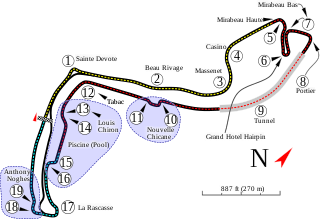
Juan Pablo Montoya Roldán, also known as JPM, is a Colombian racing driver.

BMW has been involved in Formula One in a number of capacities since the inauguration of the World Drivers' Championship in 1950. The company entered occasional races in the 1950s and 1960s, before building the BMW M12/13 inline-four turbocharged engine in the 1980s. This engine was the result of a deal between BMW and Brabham, which resulted in the team's chassis being powered by BMW engines from 1982 until 1987, a period in which Nelson Piquet won the 1983 championship driving a Brabham BT52-BMW. BMW also supplied the M12/13 on a customer basis to the ATS, Arrows, Benetton and Ligier teams during this period, with various degrees of success. In 1988, Brabham temporarily withdrew from the sport and BMW withdrew its official backing from the engines, which were still used by the Arrows team under the Megatron badge. Turbocharged engines were banned by the revised Formula One Technical Regulations for 1989, rendering the M12/13 obsolete.
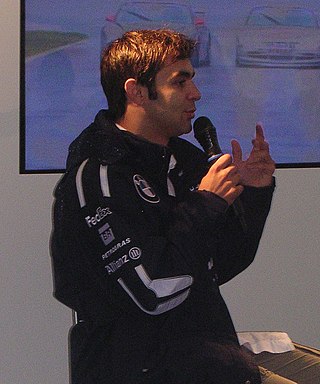
Antônio Reginaldo Pizzonia Júnior is a Brazilian professional racing driver who has raced in Formula One and the Champ Car World Series. Born in Manaus, he started his car racing career in the Formula Vauxhall Junior series in 1997 and then progressed through various junior formulae, winning the Formula Vauxhall Junior Winter Festival in 1997, the Formula Vauxhall Junior and Formula Renault Winter Festival in 1998, the Formula Renault 2.0 UK in 1999, and the British Formula 3 Championship in 2000.

The 2001 Italian Grand Prix was a Formula One motor race held on 16 September 2001 at the Autodromo Nazionale di Monza near to Monza, Lombardy, Italy. It was the 15th round of the 2001 Formula One World Championship and the 72nd Italian Grand Prix. Rookie Williams driver Juan Pablo Montoya won the 53-lap race from pole position. Rubens Barrichello finished second in a Ferrari with Montoya's teammate Ralf Schumacher third.

The 2004 Belgian Grand Prix was a Formula One motor race held on 29 August 2004, at the Circuit de Spa-Francorchamps, near the village of Francorchamps, Wallonia, Belgium. It was Race 14 of 18 in the 2004 FIA Formula One World Championship. The race was contested over 44 laps and was won by Kimi Räikkönen, taking his and McLaren's only race win of the season from tenth place on the grid. Second place for Michael Schumacher won his seventh world championship, after beating third-placed Rubens Barrichello.

The 2004 Italian Grand Prix was a Formula One motor race held on 12 September 2004 at the Autodromo Nazionale di Monza. It was Race 15 of 18 in the 2004 FIA Formula One World Championship. Ferrari took a 1–2 in front of the delighted Tifosi, with Rubens Barrichello ahead of teammate Michael Schumacher. Both cars had to make their way through the field from the back, Barrichello having made an early pitstop after choosing the wrong tyres at the start and Schumacher having spun on the first lap. This was the last race for Giorgio Pantano.
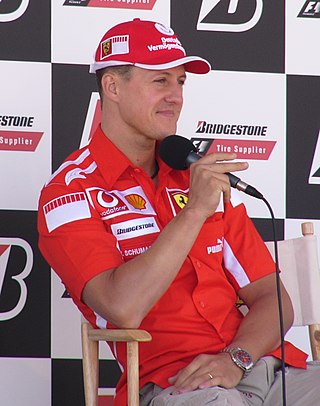
The 2004 FIA Formula One World Championship was the 58th season of FIA Formula One motor racing. It was the 55th FIA Formula One World Championship, and was contested over eighteen races from 7 March to 24 October 2004.
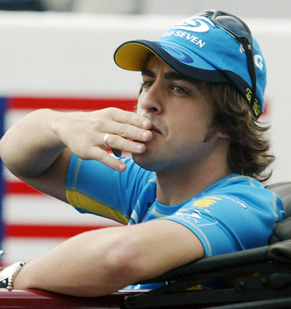
The 2005 FIA Formula One World Championship was the 59th season of FIA Formula One motor racing. It featured the 56th FIA Formula One World Championship, contested over a then-record 19 Grands Prix. It commenced on 6 March 2005 and ended 16 October.

The 2005 Belgian Grand Prix was a Formula One motor race held on 11 September 2005 at Circuit de Spa-Francorchamps near the village of Francorchamps, Wallonia, Belgium. It was the sixteenth race of the 2005 FIA Formula One World Championship and the 62nd Belgian Grand Prix.

The Williams FW25 is a Formula One car designed by Williams and powered by a BMW V10 engine. The car was used by Williams for the 2003 championship. Three drivers would drive the FW25 in the 2003 season, with Marc Gené replacing regular racer Ralf Schumacher for the Italian Grand Prix after the German suffered a large testing accident testing at Monza's Lesmo 1 corner prior to that race. The other regular driver Juan Pablo Montoya started all of the season's Grand Prix.

The Williams FW21 was the car the Williams Formula One team used to compete in the 1999 Formula One season. It was driven by Ralf Schumacher, who had swapped from Jordan with Heinz-Harald Frentzen, and Alessandro Zanardi who had last raced in Formula One in 1994, but had since won the CART championship twice.

The Williams FW27 was the Formula One car which the Williams team used during the 2005 Formula One season.

The Williams FW23 was the car with which the Williams team competed in the 2001 Formula One World Championship. It was driven by German Ralf Schumacher, who was in his third year with the team, and Colombian Juan Pablo Montoya, a previous Formula 3000 and CART champion who was making his F1 début.

The Williams FW24 was the Formula One car with which the Williams team competed in the 2002 Formula One World Championship. It was driven by German Ralf Schumacher and Colombian Juan Pablo Montoya, in their fourth and second seasons with the team respectively.

The Williams FW30 is a Formula One racing car, designed by Williams and introduced at the start of the 2008 Formula One season. The car is largely an evolution of the previous, 2007-season, Williams model: the FW29. As with its predecessor, the FW30 is powered by engines manufactured by Toyota. The FW30 was unveiled to the public on 21 January 2008 at the Circuit de Valencia, Spain, and made its race debut at the 2008 Australian Grand Prix in the hands of 2008 Williams drivers Nico Rosberg and Kazuki Nakajima.

The Williams FW34 was a Formula One racing car designed by Williams F1 for the 2012 Formula One season.
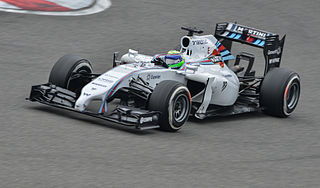
The Williams FW36 is a Formula One racing car designed by Williams Grand Prix Engineering to compete in the 2014 Formula One season. It was driven by Valtteri Bottas and Felipe Massa, who replaced the departing Pastor Maldonado.

The BMW E41 and P80 series is a family of naturally-aspirated Formula One racing engines, designed and developed by BMW, and introduced in 2000 in partnership with Williams, and continued through 2006, during their partnership with Sauber.












